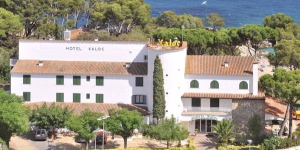
The Empordà, the Costa Brava, was the entry point of the Romans on the Iberian Peninsula. Many colonies were organized around this area, taking advantage of the good weather and the resources offered. This is the case of the Roman Villa of Pla de Palol, close to Cala Rovira, in Platja d'Aro. It was a villa in where wine and oil were produced and exported from the Roviera port to the rest of the Roman Empire. Occupied between I B.C. and VII A.D. centuries here we find traces of rooms, deposits and thermae that testify that during their occupation it was carried out both domestic and work life.
Roman villa of Pla de Palol Map
- Apartments(27)
- Villas(7)
- Campings(4)
- Hotels(25)
- Beaches(6)
- Feast days(3)
- Roman villas(1)
- Nature reserve(1)
- Megaliths(1)
How to arrive to Roman villa of Pla de Palol?
How to arrive from:Roman villa of Pla de Palol Photos
Other interesting places near here
-
 2.2 miles away
2.2 miles awayLocated on the coast of Calonge, in Sant Antoni, Torre Valentina witnesses a distant past in which this same place was occupied by a farmhouse and its tower to protect the farmers from pirate attacks. Erected between the XVth and XVIth centuries, with cylindrical base, it has three floors, a common design those days ......
-
 3.4 miles away
3.4 miles awayThe International Music Festival s'Agaró is celebrated during the months of July, August and September, in a series of classical music concerts with international artists. The stage is held in the s'Agaró old church, near the sea, with performances ranging from bel canto, chamber quartets, piano concertos, violin, and thematic nights dedicated to great historical musicians like Wagner, Verdi, Handel, etc.. Look out the concert program and ticket prices, which can be purchased online at the website of the festival organized by the Pau Casals Association since 1998.
 3.7 miles away
3.7 miles awayNext to the church, the restored Castell de Benedormiens looks as though it’s grown out of the rock. Built in the eleventh century, it was burnt in 1462 and then destroyed by an explosion in 1879, after which it was left to moulder until restoration last century. Little of the original structure remains, although excavations in the old moat are turning up some finds, including many relating to an iron-wo......
Quick search
...and near here:
Hotels Platja d'Aro (25)
-
 H Top Caleta PalaceFrom 0.00€
H Top Caleta PalaceFrom 0.00€ -
 Aparthotel Ciutat de ...301From 0.00€
Aparthotel Ciutat de ...301From 0.00€ -
 Hotel Els Pins425From 0.00€
Hotel Els Pins425From 0.00€ -
 Columbus330From 0.00€
Columbus330From 0.00€ -
 Hotel Bell Repos337From 0.00€
Hotel Bell Repos337From 0.00€ -
 Planamar381From 0.00€
Planamar381From 0.00€ -
 Cap Roig475From 0.00€
Cap Roig475From 0.00€ -
 GHT Xaloc107From 0.00€
GHT Xaloc107From 0.00€ -
 Medplaya Hotel Monterrey216From 0.00€
Medplaya Hotel Monterrey216From 0.00€ -
 Hostal La MarinaFrom 0.00€
Hostal La MarinaFrom 0.00€ -
 Hotel S'Agoita230From 33.00€
Hotel S'Agoita230From 33.00€ -
 Pinar del Mar176From 39.00€
Pinar del Mar176From 39.00€ -
 Hotel Bulevard171From 40.50€
Hotel Bulevard171From 40.50€ -
 Hotel Claramar500From 41.00€
Hotel Claramar500From 41.00€ -
 H Top Platja Park206From 43.20€
H Top Platja Park206From 43.20€ -
 Hotel Aromar463From 44.00€
Hotel Aromar463From 44.00€ -
 NM Suites335From 44.10€
NM Suites335From 44.10€ -
 Aparthotel Comtat San...494From 45.00€
Aparthotel Comtat San...494From 45.00€ -
 Hotel Costa Brava121From 49.00€
Hotel Costa Brava121From 49.00€ -
 Silken Park Hotel San...2359From 50.00€
Silken Park Hotel San...2359From 50.00€ -
 Panama87From 55.00€
Panama87From 55.00€ -
 Hotel La Terrassa Spa...646From 56.00€
Hotel La Terrassa Spa...646From 56.00€ -
 Cosmopolita Hotel Bou...From 60.00€
Cosmopolita Hotel Bou...From 60.00€ -
 Hapimag Resort Mas Nou245From 92.00€
Hapimag Resort Mas Nou245From 92.00€ -
 Hotel & Spa Cala ...503From 139.00€
Hotel & Spa Cala ...503From 139.00€
Costa Brava Guide
2024 @Costa Brava's. All Rights Reserved.



